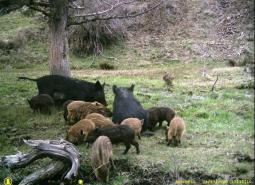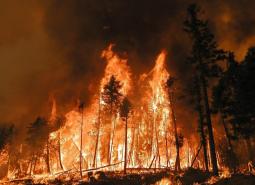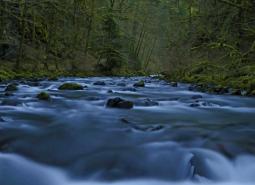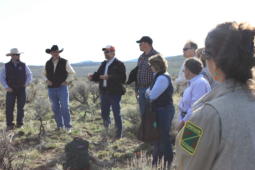Overview
Key Conservation Issues (KCIs) are large-scale conservation issues or threats that affect or potentially affect many species and habitats over large landscapes throughout the state. They also affect people by reducing land productivity, reducing opportunities for recreation, altering water supplies, or increasing risk of severe wildfires. As a result, problems affecting large areas must be considered across jurisdictional and ownership boundaries. This section of the Conservation Strategy describes the seven KCIs affecting Oregon, and the recommended conservation goals and actions needed to address them.
Each KCI provides an overview of the statewide threat and information on recommended actions. The background text is intended to serve as a starting point for agencies and organizations working on these issues to chart a course over the coming decade. The background text is also intended for landowners and natural resource managers looking for ideas and rationale for conservation actions.
Many of the KCIs are highly intertwined. For example, changes in fire and flood regimes often happen when land is developed for new communities. Invasive species can be spread as more people move into new areas. Climate change will affect how many of the other issues impact Oregon’s landscapes. How all of these issues play out over the coming decade will be influenced by changes in Oregon’s community development patterns and anticipated population increases.
For all recommended actions, implementation will depend on cooperative efforts by a variety of entities and may be contingent on funding, statutory authority, and other factors. Actions need to be compatible with local priorities, local comprehensive plans and land use ordinances, as well as other local, state, or federal laws. Actions on federal lands must undergo federal planning processes prior to implementation to ensure consistency with existing plans and management objectives for the area. In many cases, these actions are already occurring and should be continued or expanded. In other cases, new actions are identified.
Recommended Actions for all Key Conservation Issues
The overall goals for the Oregon Conservation Strategy are to promote healthy fish and wildlife populations by maintaining and restoring functioning habitats, preventing declines of at-risk species, and reversing any declines in these resources where possible. Reducing and reversing the impacts of the KCIs can contribute significantly to these goals, while also contributing to healthy human communities. Recommended actions for all KCIs include:
- Working with community leaders in both urban and rural areas, and working with agency partners to ensure planned, efficient growth and development, and to preserve fish and wildlife habitats, farms, forest and rangeland, open spaces, and recreation areas.
- Helping landowners and agency partners find reliable and useful information about fish, wildlife, and habitats early in the project planning process.
- Funding, utilizing, and improving financial incentive programs and other voluntary conservation tools to support conservation actions taken by landowners and land managers.
- Developing new voluntary conservation tools to fulfill identified needs.
- Promoting collaboration across jurisdictional and landownership boundaries. Integrating information about fish, wildlife, and habitats with collaborative frameworks, such as the Climate Adaptation Framework and the Integrated Water Resources Strategy.
- Helping private landowners, public land managers, and citizens find ways to restore and protect Strategy Habitats and ecosystem services. Working creatively to find new opportunities and solutions.
- Informing Oregonians of conservation issues and the actions everyone can take that will contribute to Oregon’s collective success.
For information on issues impacting nearshore species and habitats, see the Nearshore Strategy.
Key Conservation Issue Leadership
Further efforts to develop specific action items are recommended, and should involve all parties that are key to success. The Stakeholder Advisory Committee recommended that the Conservation Strategy outline lead organizations for each KCI, and provide ideas for several supporting organizations that will be important for successful implementation. See the table below for recommendations, which are simply a starting point and are not intended to be all-encompassing.
| Key Conservation Issue | Lead Organization(s) | Key Supporting Organizations |
|---|---|---|
| Climate Change | OGWC | ODOE, ODEQ, DLCD, OSU, Univ of WA, ODFW, USGS, NW CSC, USFWS, BLM, USFS |
| Land Use Change | DLCD | DSL, ODOE, ODFW, AOC |
| Invasive Species | OISC | ODFW, ODA, ODF, ODEQ, PSU, INR, OSMB, SWCD, BLM, USFS |
| Disruption of Disturbance Regimes | ODF, DLCD | FEMA, ODFW, BLM, USFS, NOAA, USACE |
| Barriers to Fish & Wildlife Movement | ODFW | OWEB, ODOT, USFWS, USFS |
| Water Quality & Quantity | ODEQ, OWRD | ODA, ODFW, ODF, DSL, NOAA, USACE |
| Challenges and Opportunities for Private Landowners to Initiate Conservation Actions | ODFW, OWEB | SWCD, NOWC, COLT, DOW, INR, TPL |

Climate Change
Changes in climate influence habitats for fish and wildlife, and affects the fundamental conditions in which species can exist. Climate change can also affect landscape conditions like wildfires, flooding, drought, coastal erosion, landslides, and invasive species.

Land Use Changes
Human presence has always altered the shape, appearance, and function of ecosystems. The Conservation Strategy promotes compatible actions and goals that address urbanization and energy development, while being mindful of species conservation needs.

Invasive Species
The impact of invasive species is a serious problem to species and habitat conservation across this United States. Many non-native invaders occur in Oregon causing serious economic and environmental harm. This section addresses invasive species that are a concern in Oregon and promotes the framework for action to avoid, eliminate, or reduce risks to our native wildlife species.

Disruption of Disturbance Regimes
Natural disturbances in the environment shape Oregon’s landscapes by resetting plant succession creating new habitats, and maintaining native habitats such as grasslands and savanna. The recommended approach in the Conservation Strategy is to restore or mimic fire and flooding disturbance regimes to benefit fish and wildlife and reduce risks to people.

Barriers to Animal Movement
Mobility of many species across the landscape is crucial for them to survive and reproduce successfully. Human-caused changes to the landscape can seriously impact the ability of fish and wildlife to move across terrestrial landscapes or along aquatic habitats by adding obstacles, impacting critical stopover sites, and increasing habitat fragmentation.

Water Quality and Quantity
The goal of this section is to maintain and restore water quality and quantity to support native fish and wildlife and habitats in balance with the economic and social needs of rural and urban communities. The Conservation Strategy promotes and encourages goals and actions to safeguard Oregon’s priority species and their habitats, and outlines the challenges and opportunities.

Challenges and Opportunities for Private Landowners to Initiate Conservation Actions
Throughout Oregon, landowners are making a difference by instituting conservations actions on their private lands. However, landowners need to assess which aspects of a project they can do themselves, which require assistance, and know whom to ask for guidance. This section outlines challenges faced by many private landowners and potential opportunitie to address them.